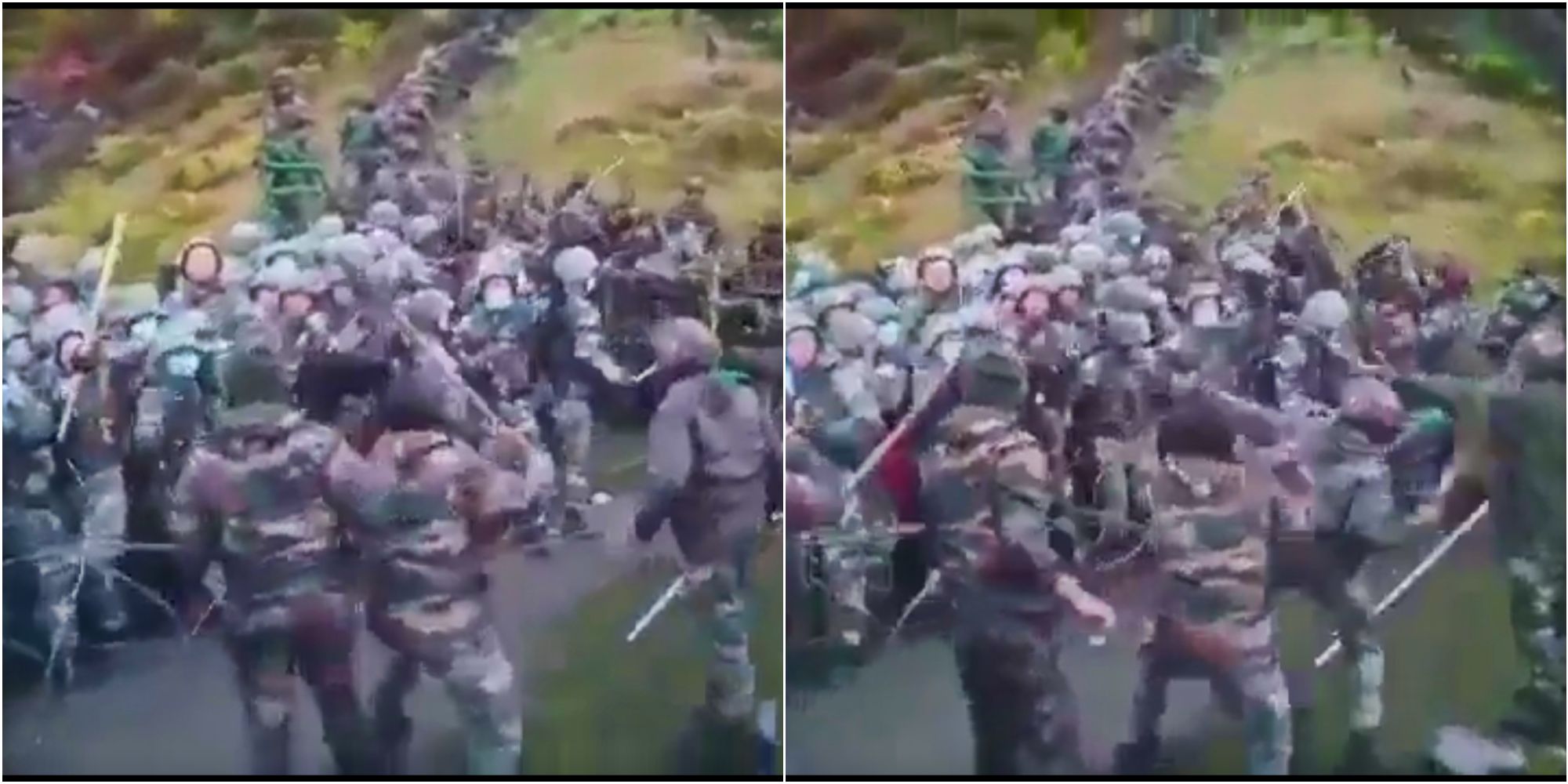China’s aggressive manoeuvres against the Philippines in the disputed Second Thomas Shoal may have gone too far this time, as reports emerge of Chinese Coast Guards brandishing sharp-edged weapons against Filipino troops. Many experts have connected this incident to the India-China clash in Galwan Valley, Ladakh.

The latest skirmish occurred as Philippine Coast Guard and Navy personnel were delivering supplies to Filipino troops stationed on the Sierra Madre warship near the Second Thomas Shoal. The warship, run aground by the Filipinos, operates as a military outpost in the region. China frequently attempts to thwart these missions, sometimes using force. This time, however, it turned out to be a bloody engagement.
The Philippines’ top military commander, General Romeo Brawner, said Chinese ships allegedly slammed Philippine boats, boarded them, and took their weapons away. A Filipino soldier lost his thumb when his vessel was hit by the Chinese, the General said.
Although Beijing has maintained that its personnel practised restraint, the Filipino general said two inflatable boats of the Philippine Navy were repeatedly hit by over eight motorboats carrying Chinese forces, who subsequently boarded them. Manila has also accused the Chinese soldiers of stealing firearms and demanded that the rifles and other equipment be returned.
The Philippine military released images and video of the violent confrontation, showing Chinese soldiers on boats near Manila’s ship outpost encircling two Philippine navy supply boats with sticks, knives, and axes. The Chinese struck the Philippine navy boat with a pole while sirens blared nonstop, and both sides yelled at one another.
The Chinese reportedly took control of the boats and used hammers, machetes, and knives to damage them following a skirmish and several deliberate collisions. This may have been the first of its kind of attack in the contested South China Sea. The Armed Forces of the Philippines said the Chinese Coast Guard crew harassed them with “physical attacks, the use of bladed weapons… and blinding strobe lights”.
As per reports, sharp objects and weapons were used to puncture the rubber boats, deflate them, and make them inoperable. Some accounts suggested that weapons were also used to threaten the Filipino soldiers who were on a routine replenishment mission to a region that Manila claims as its sovereign territory.
Photographs show a damaged Philippine naval vessel with its side floaters cut and deflated and another vessel with its windshield and navigation screens broken. The photos also show the severely damaged Filipino vessels’ communication and navigation equipment.
Philippines-based military analyst Miguel Miranda told EurAsian Times, “What happened to the Philippine Navy’s latest attempt at a resupply mission to the BRP Sierra Madre in Ayungin Shoal (Second Thomas Shoal) fits a very clear pattern of harassment and violence that started once Pres. Marcos entered office in the middle of 2022. Short of using live ammunition, the Chinese Coast Guard has employed every other means to assault and harm Filipinos inside the territory of the Philippines. It’s absurd warfare, but the intent is clear enough: China is using a sizable armada to annex Philippine waters while its Navy is always sailing around nearby, with the grunt work done by all sorts of other watercraft.”
However, China attributed the conflict to the Philippines, claiming that despite its warnings, the Filipino personnel “trespassed” into the shoal.
The Chinese Foreign Ministry spokesperson Lin Jian said, “This is the direct cause of the incident. The Chinese coast guard at the scene has taken professional law-enforcement measures with restraint aimed at stopping the illegal supply mission by the Philippine vessels, and no direct measures were taken against the Philippine personnel.”
However, as these accounts started appearing, several netizens and social media military watchers likened the incident to what Chinese troops had pulled off against India in the Galwan Valley clash in 2020. Several users on X (previously Twitter) wrote that China’s recent actions in the South China Sea were a Galwan 2.0.
One user wrote: A nuclear-armed nation using spears to try to bully its neighbours. First India in Galwan and now the Philippines. Who is next?”
Reminiscent Of Galwan Clash
It was the first time Chinese Coast Guards were spotted with spears, knives, and bolos (usually used to describe a wide range of Philippine single-edged machete-like tools and weapons). General Brawner said that since the guns of the Filipino troops were disassembled and stored in cases, they were not armed. The officials claimed that the Filipino boat crew members were instructed not to brandish their firearms.
Brawner stated that even though the eight-boat Chinese Coast Guard detachment had “outnumbered” them, Filipino personnel had “fought back with our bare hands” after seeing the injured sailor.
Incidentally, the confrontation happened on June 17, almost four years after a similar June 15 Galwan clash between Chinese PLA troops and Indian soldiers in 2020, which involved hand-to-hand combat. India lost 20 of its soldiers. China later admitted that it lost four or five soldiers. Reports, however, suggested that it may have lost about 40 soldiers.
Chinese troops used iron rods studded with metal tips and stones against the Indians as they were not allowed to use firearms due to the confidence-building agreements. China and India remain embroiled in a border dispute along the Line of Actual Control (LAC) that has resulted in multiple standoffs between their forces over the years.
Much like the latest attack on the Philippines, the Galwan clash came after several confrontations between the two sides.
The brawl started when Chinese soldiers were sent to block India’s efforts to build a road that would give its forces easier access to the area. In retaliation, India sent out its forces. By May 2020, the two sides were already engaged in combat, not only in Ladakh but also in Sikkim, another frontier region located 1,200 kilometres to the east.
Hours of hand-to-hand fighting took place on the rocky, steep terrain using iron rods, rocks, and fists. There were no guns on any side. In the fiercest battle between China and India in 60 years, the majority of the men slain either lost their footing or were thrown off the narrow Himalayan ridge and fell to their deaths.
The combat started when a patrol of Indian soldiers came face-to-face with Chinese troops on a precipice in the mountainous region.
India accused the Chinese troops of violating the disengagement agreement and carrying out a “pre-meditated and planned action” against Indian troops that were “directly responsible for the resulting violence and casualties.”

The Indian side noted that 20 Indian Army personnel were killed by the Chinese troops and used clubs, iron rods, nails-studded sticks, and stones. Indian government sources told the media that the Chinese troops were carrying ‘Guandao,’ which is a kind of Chinese pole weapon used in some forms of Chinese martial arts. It has a blade mounted atop a long wooden pole.
Similar to its reaction to the recent Filipino accusations, the Chinese side said at that time that India alone was to blame for the confrontation. It claimed that Indian forces had illegally entered the Chinese side of the Line of Actual Control three times. Chinese Foreign Minister Wang Yi then asked India to punish its personnel for these violations.
When asked if there were any parallels between the Galwan clash and the recent clash in the Second Thomas Shoal, another military expert who did not wish to be quoted said, “Not really. The difference is that the Philippines did not fight back. In Galwan, the Indian Army fought back.”



